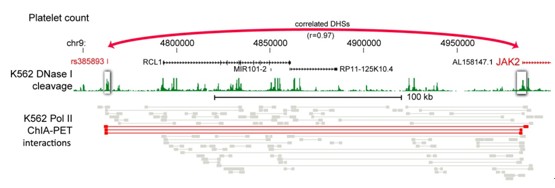Systematic Connecting Common Disease-associated Variation with Regulatory DNA
Studies that compare the genomes of sick and healthy individuals have turned up a plethora of gene variants that are associated with certain diseases. A new study conducted by Professor John A. Stamatoyannopolous and his colleagues marshals this information into a more complete picture of how many of these variants contribute to diseases such as multiple sclerosis, Crohn's disease and heart disease. Dr. QU Hongzhu from Beijing Institute of Genomics(BIG), Chinese Academy of Sciences joined in this research.
Scientists analyzed 349 human cell and tissue samples covering all major organ systems in adults and stages of human development studied under the Encyclopedia Of DNA Elements9(ENCODE) Pr. The Roadmap Epigenomics Program and the 1000 Genomes Project crossing with data from genetic studies of over 400 common diseases and clinical traits. They determined that many noncoding, disease-associated variants are located near regulatory DNA marked by deoxyribonuclease I (DNase I) hypersensitive sites (DHSs). They identified distant gene targets for hundreds of variant-containing DHSs that may explain phenotype associations. The regulatory role for these variants appears to be specific to particular tissue types and developmental stages.Most changes were active during early human development, when body tissues are most vulnerable. Disease-associated variants systematically perturb transcript ion factor recognition sequences, frequently alter allelic chromatin states, and form regulatory networks.
The results indicating widespread and systematic localization of variants associated with a wide spectrum of common diseases and traits in regulatory DNA marked by DHSs highlight a continuous quantitative spectrum of disordered gene regulation between common disease and Mendelian traits, and lend a new perspective on the genetic architecture and heritability of common human diseases and phenotypic traits.

Candidate regulatory roles for GWAS SNPs (Image by Stamatoyannopoulos Lab at University of Washington ).
Paper link: http://www.sciencemag.org/content/337/6099/1190.long
Contact: Prof. John A. Stamatoyannopolous
Email: jstam@u.washington.edu
Dr. Matthew T. Maurano
Email: maurano@u.washington.edu
Dr. Hongzhu Qu
Email: quhongzhu@big.ac.cn